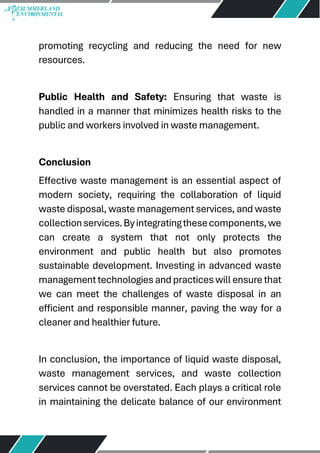7 Simple Techniques For Reclaim Waste
7 Simple Techniques For Reclaim Waste
Blog Article
The Facts About Reclaim Waste Uncovered
Table of ContentsAll About Reclaim WasteAbout Reclaim WasteReclaim Waste Things To Know Before You BuyExcitement About Reclaim WasteFacts About Reclaim Waste Uncovered
Check out the types, occurrences, and types of fluid waste. Residential sewage waste describes the waste and items from a household sewage-disposal tank. This kind of waste is produced by humans in homes, schools, and various other buildings. This only consists of septic storage tanks that have a drain area. The correct administration and disposal of domestic sewer waste require liquid waste to be moved to a sewage treatment plant where the correct techniques and tools are applied to detoxify and dispose of waste.
Industrial waste often consists of possible risks, such as combustible materials or a mix of fluid and solid waste products, and needs an extra advanced and thorough disposal process. The disposal of business waste generally includes the purification of waste before transportation to guarantee risk-free and appropriate disposal. Hazardous waste is produced from by-products and drainage of commercial processes and production.
This kind of waste can not make use of the very same sewage management transport or procedures as septic or business liquids. The commercial waste management process needs the examination and testing of liquid waste before it undertakes the disposal procedure (liquid waste disposal). Runoff waste is the liquid waste that originates from overflow and excess stormwater in extremely inhabited locations or cities
Runoff waste can trigger contamination and flooding otherwise taken care of correctly. Discover more about sewer cleaning and waste administration. Making certain correct waste administration can protect against calamities and decrease environmental harm. Both people in household setups and specialists in commercial or production markets can benefit from comprehending the processes and policies of fluid waste monitoring.
Some Ideas on Reclaim Waste You Should Know
Get in touch with PROS Providers today to learn more about our waste management and disposal services and the appropriate ways to care for the liquid waste you generate.
(https://www.tumblr.com/reclaimwaste1/766851148823068673/at-reclaim-waste-were-a-national-solutions?source=share)This supposed 'wastewater' is not just a vital resource however, after therapy, will certainly be released to our land, rivers or the sea. Utilized water from commodes, showers, baths, cooking area sinks, washings and industrial processes is known as wastewater.

water utilized to cool equipment or tidy plant and equipment). Stormwater, a type of wastewater, is runoff that streams from farming and urban areas such as roofings, parks, yards, roads, paths and gutters right into stormwater drains, after rainfall. Stormwater flows untreated directly to neighborhood creeks or rivers, at some point getting to the sea.
All about Reclaim Waste
In Queensland, many wastewater is dealt with at sewer therapy plants. Wastewater is delivered from residential or industrial websites via a system of sewage systems and pump stations, understood as sewerage reticulation, to a sewage therapy plant.
The Division of Natural Resources advises regional governments regarding managing, operating and maintaining sewerage systems and therapy plants. In advice unsewered areas, neighborhood governments may require householders to mount specific or household sewage treatment systems to treat domestic wastewater from commodes, kitchen areas, bathrooms and washings. The Department of Natural Resources authorises using house systems when they are verified to be reliable.
Most stormwater receives no treatment. In some new subdivisions, therapy of some stormwater to remove trash, sand and gravel has actually started making use of gross pollutant traps. Wastewater treatment occurs in 4 stages: Removes solid matter. Bigger solids, such as plastics and other items incorrectly released to drains, are removed when wastewater is gone through displays.
Wastewater then streams into large tanks where solids clear up and are removed as sludge. Grease and residue are skimmed from the surface. Makes use of little living organisms called micro-organisms to break down and get rid of continuing to be dissolved wastes and great fragments. Micro-organisms and wastes are included in the sludge. Removes nitrogen and phosphorus nutrients that might create algal blossoms in our rivers and endanger water life.
Some Known Details About Reclaim Waste
Nutrient elimination is not offered whatsoever sewage treatment plants since it calls for pricey specialist tools. It is becoming more usual in Queensland. Clear fluid effluent created after therapy may still consist of disease-causing micro-organisms. If this effluent is launched into waterways such as rivers or the sea, the micro-organisms will ultimately die out.

The majority of wastewater flows into the sewerage system. Under the Act, regional governments administer approvals and licences for eco relevant tasks (Ages) entailing wastewater releases that might have a local effect.
Some Known Factual Statements About Reclaim Waste
Monitoring offers factual info concerning water high quality and can validate that licence conditions are being fulfilled. The details obtained with tracking supplies the basis for making water quality choices.
Report this page